How to replace your iPhone 7 Plus screen
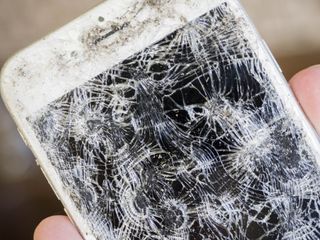
The iPhone 7 Plus's screen is beautiful, to be sure — but that glass beauty can break if dropped, smashed, or otherwise chipped against similarly-hard surfaces. Some breaks are worse than others, but if you completely smash your screen, you're probably in need of a screen repair.
After all, modern iPhone screens aren't just LCD and glass: They pack several different components in one. The digitizer reads your finger contact and movement; the LCD displays all the images, video, and other visual information, and the glass screen helps shield the inner components of the phone. As such, whether you crack the glass, run into a black screen, or can't interact with your phone via touch, you'll need to replace the entire screen to get your phone working properly again. When you crack your screen, it also destroys your iPhone's water resistance; if you're used to keeping it near water, you'll definitely want to fix your device.
There are several ways to repair or replace a broken iPhone screen, depending on your monetary situation and free time. Here are a couple, in order of easiest (and cheapest) to most complicated.
- Buy a screen protector
- Get Apple to fix it
- Fix it yourself
- Required tools and parts
- Open the iPhone
- Disconnect the cables
- Remove the camera and speaker
- Remove the home button
- Replace the screen
- Put it all back together
Buy a screen protector
If your screen is shattered but relatively intact, you can put off a potentially-costly repair by sealing the broken pieces behind a screen protector. I'll note that this is a temporary measure, and one I generally recommend for screens that are cracked, but not completely destroyed — it can keep the cracks from worsening or pieces of the screen from falling apart, but eventually, you'll need to replace the screen. It also won't maintain your iPhone's water resistance.
Make an appointment with Apple

The iPhone 7 and 7 Plus screens have more complicated technology embedded within them than any iPhone before them: Between the Touch ID sensor, Taptic Engine-based Home Button, 3D Touch display, and FaceTime front-facing camera, a cracked iPhone screen can be a real hassle to replace.
Luckily, if you purchased AppleCare+ with your iPhone, a screen repair is simple and inexpensive — assuming you have the time to send it to Apple. It's just $29 to fix a broken iPhone 7 or 7 Plus screen, and an Apple Store or Apple Authorized Service Representative store you visit has the equipment necessary to properly remove, replace, and re-calibrate your iPhone for Touch ID and water resistance.
Master your iPhone in minutes
iMore offers spot-on advice and guidance from our team of experts, with decades of Apple device experience to lean on. Learn more with iMore!
Repair the screen yourself

In past years, we've recommended this option above making an appointment with Apple, but as the iPhone screen has gotten more complicated — a home-brew repair can potentially hinder your device from full operability. (You won't be able to re-calibrate your screen for water resistance, for instance.)
But if you'd prefer to repair your gadgets yourself, here's the best way to go about it.
Before you consider a repair...
If your glass is intact, but your screen is black or you have lost touch control, you should always try a soft reset of your iPhone before this repair.
- Press and hold the Power button on the right side of your phone.
- While holding the Power button down, press and hold the Volume Down button on the left side of your phone.
- Hold both buttons down until you see the Apple logo on the screen.
If the Apple logo doesn't appear after holding down the buttons and waiting for at least 90 seconds, your phone likely needs a screen repair.
Always make sure to back up your phone before any repair.
General repair guidelines
- Always use good lighting - smart device components are small and you'll need plenty of light to see what you are doing.
- Maintain a clean, organized workspace so you don't lose or confuse any components.
- Group your screws so you can keep track of where they came from. Most screws cannot be interchanged.
- Apply enough heat to loosen adhesive but not enough to damage the device.
- At any point during a repair, if the adhesive becomes hard to separate, apply more heat.
- After separating adhesive, keep the housing and screen in close proximity until flex cable is disconnected.
How to replace a broken iPhone 7 Plus screen
The iPhone 7 Plus LCD screen assembly is difficult to remove and replace: Several flex cables can be torn easily, so proceed carefully. In addition, loosening the screen's adhesive requires controlled heating with a dehydrator or heat gun.
Required tools and parts
Not only will need a new screen — an "LCD Assembly", if you want to be technical about the part — you're going to need some tools if you're going to do this right. Or at all.
- iPhone 7 Plus LCD assembly
- Metal spudger
- Phillips head srewdriver
- Pentalobe screwdriver
- Tri-point screwdriver
- Spudger
- Dehydrator, heat Gun, or heat mat
While not required to repair your iPhone, we also recommend you use a magnetic mat and screw capsules to keep everything organized. You're going to be working with some tiny screw here; these will help you keep them on your table and not lost on the floor.
Turn your iPhone off and heat it up.
Start by heating up the device's interior adhesive strips with a dehydrator, heat gun, or heat mat. Heat guns are the quickest, but be careful because it is easy to overdo it and damage the device. Twenty minutes in the dehydrator should be enough. Ten to twenty seconds of a heat gun on a low setting should be all you need to loosen the adhesive.
Open the iPhone
- Remove the two pentalobe screws on the bottom edge of the phone. They are on either side of the lightning port.
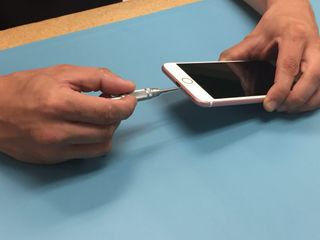
- Using the metal spudger, slowly and carefully separate the screen of the iPhone from the body. Start on the bottom edge by the Lightning port and proceed slowly.
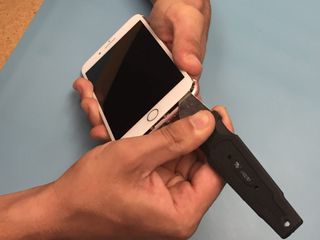
- Continue using the metal spudger or use playing cards or guitar picks to separate the adhesive from the sides and top. Don't push the metal spudger too far into the device.
- The left side of the screen will open off the body like a book opened from the back cover. The flex cable connecting the screen to the battery will still be attached, so exercise caution.
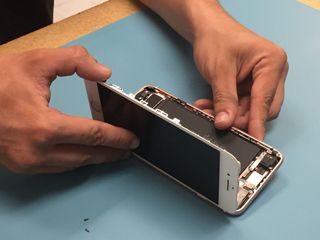
Disconnect the cables
- Remove the silver EMI shield on the mid-right side of the phone needs. It is secured by four tri-point screws; one of those screws is longer than the others.

- After the shield is off, use a spudger to disconnect the battery from the logic board.
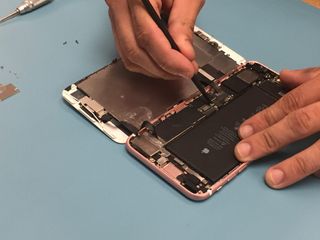
- Disconnect the display connector flex cable using the spudger.
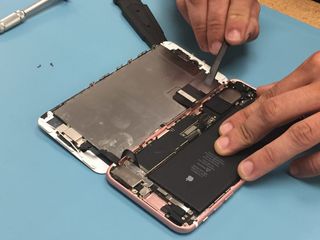
- Unscrew the two Philips head screws on the shield over the front panel sensor assembly connector; that's the silver shield near the top of the phone with the flex cable coming out of the bottom.
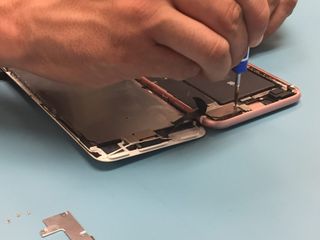
- Disconnect the black front panel sensor assembly connector cable from the logic board with the spudger: It's the one that connects the screen to the iPhone's body.

- Remove the LCD assembly of the iPhone 7 Plus from the body.
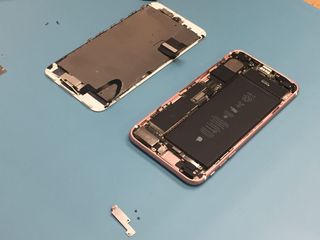
Remove the front camera and earpiece
- Next, we will remove the five Phillips head screws that hold the silver bracket on the top of the LCD assembly.

- Pull the front camera up and out of the way with your spudger or tweezers.
- You can now also remove the earpiece speaker.

- Use your spudger to remove the ambient light sensor and proximity sensor. This is a thin cable that is easy to tear so use caution.

Remove the Home Button / Touch ID
The Touch ID sensor must be removed carefully. Failing to remove it safely or breaking any of its connectors will require visiting an Apple Store.
- Unscrew the pentalobe screws holding the Touch ID and home button bracket.
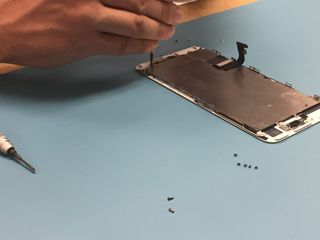
- Remove all the screws around the sides of the LCD shield. There are 5 tri-point screws and 1 Philips head screw on the bottom edge.

- Pull the LCD shield away from the screen. The flex cable passes through an opening on one side.
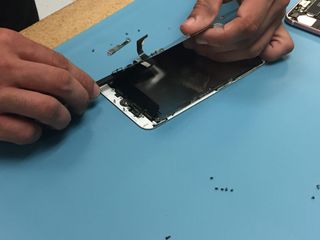
- Using your spudger, disconnect the home button cable connector.
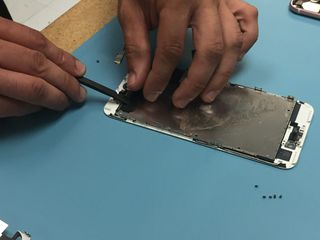
- Disconnect the underlying connection carefully.
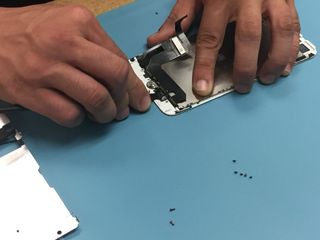
- Pry the adhesive holding the Touch ID and Home button to the back of the digitizer.
- Push the home button forward through the front of the screen.
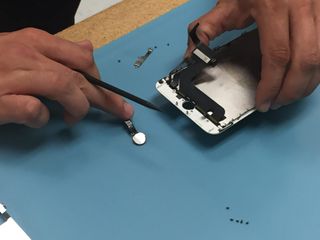
Replace the screen
- Insert the home button into the new screen from the front.

- Reconnect the home button flex cable.
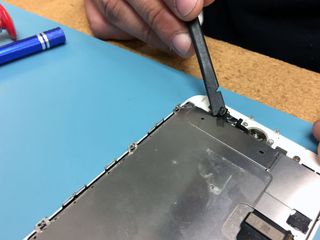
- Pass the flex cable through the LCD shield.
- Set the LCD shield in place over the screen.
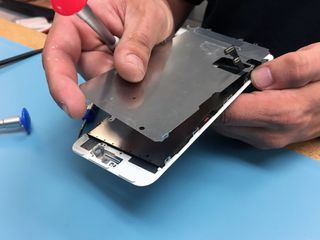
- Screw the 5 tri-point screws and single Philips head screw that fasten the LCD shield to the screen.

- Re-attach the home button bracket. There are four tri-wing screws. Do not overtighten as this can cause home button issues. The shorter screw goes directly on the home button.

- Using your plastic spudger, gently press the ambient light and proximity sensor back into place.

- Re-install the front camera.

- Re-install the earpiece speaker.

- Attach the bracket over the front camera. It needs five Phillips heads.
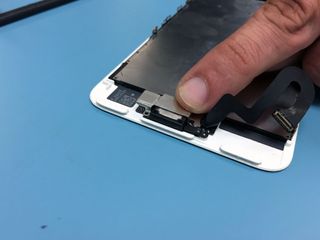
Put the components back together
- Reconnect the front-facing camera flex to the logic board.
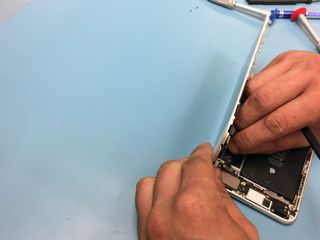
- Screw in the front facing camera EMI shield using two Philips head screws.

- Reconnect the display flex cable.
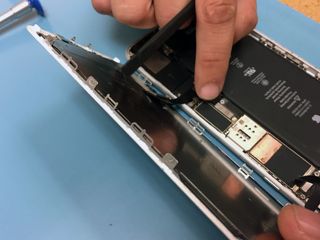
- Fasten the display flex EMI shield back onto the mid-right side of the phone using its four tri-point screws. The longer screw goes in the right corner.
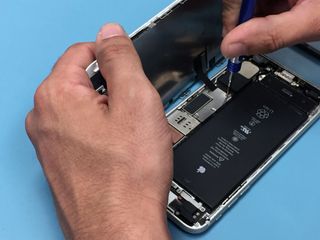
- Fold the screen over the body. Insert the top of the screen into the frame first. Proceed carefully, it will click back into place but don't press too hard on the glass.

- Screw in the two pentalobe screws that go on either side of the lightning port.
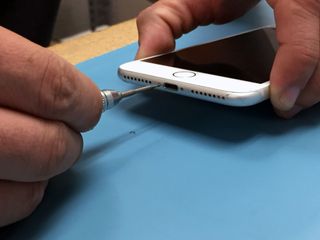
Run into trouble?
If you have any other questions about this repair, or if you find this iPhone 7 Plus repair too complicated to attempt on your own, check out iMore's repair partner iFixYouri online at www.ifixyouri.com or at 888-494-4349.
Chris is the founder of iFixYouri, a repair company specializing in smartphones, tablets, computers, and all things electronic. They repair thousands of smart devices on-location in Palm Beach County, Boston and the greater Orlando area each month. The iFixYouri warehouse space is a state-of-the-art repair depot for our corporate and website customers. In addition, iFixYouri now also provides electronics recycling, device buy-back, refurbished device sales, and smart home setup.
Most Popular





